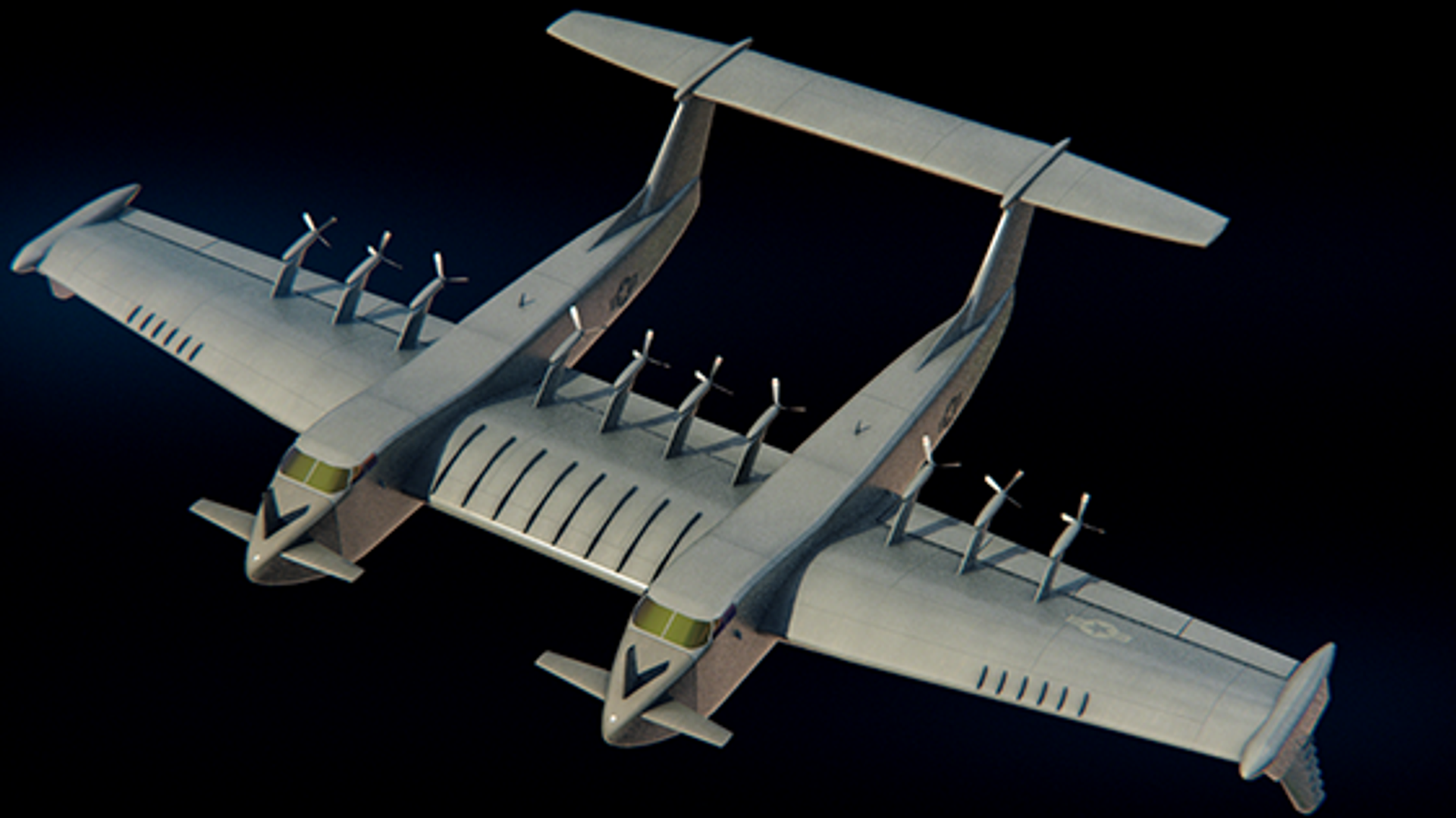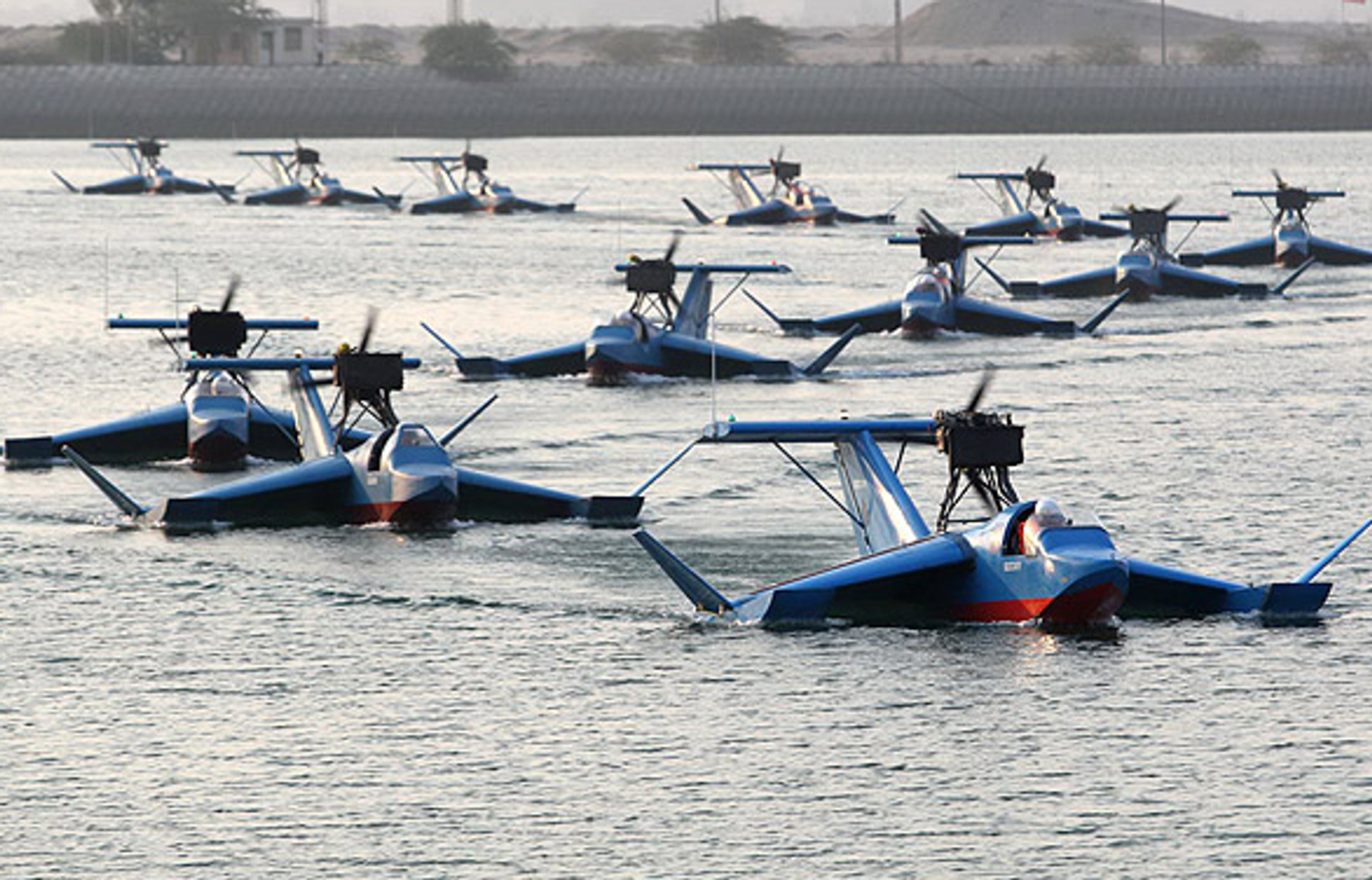https://sputnikglobe.com/20220528/darpa-dusts-off-60-year-old-soviet-ground-effect-vehicle-concept--video-1095849458.html
DARPA Dusts Off 60-Year-Old Soviet Ground-Effect Vehicle Concept – Video
DARPA Dusts Off 60-Year-Old Soviet Ground-Effect Vehicle Concept – Video
Sputnik International
Ground-effect vehicles are designed to glide over the seas making use of the ground effect - an aerodynamic interaction between their wings and the surface... 28.05.2022, Sputnik International
2022-05-28T14:47+0000
2022-05-28T14:47+0000
2022-05-28T15:55+0000
ground effect vehicle
darpa
ekranoplan
comeback
https://cdn1.img.sputnikglobe.com/img/07e6/05/1c/1095849404_29:0:591:316_1920x0_80_0_0_7d02db16a44205bb391b3187f3b8b123.png
The Defence Advanced research Project Agency (DARPA) has begun work on a new wing-in-ground effect aircraft concept dubbed the "Liberty Lifter", with the preliminary design looking like a cross between Soviet engineer Rostislav Alexeyev’s ekranoplans and Howard Hughes’ H-4 Hercules (aka. the Spruce Goose).In a press release issued last week, DARPA promised to design, build, and fly a “long-range, low-cost X-plane capable of seaborne strategic and tactical lift”, with the vehicle expected to complement “existing cargo aircraft by proving revolutionary heavy air lift abilities from the sea”.The Pentagon R&D arms makes no secret of taking inspiration from Alexeyev’s work, using archive footage of an ekranoplan and noting that “like previous large wing-in-ground effect designs”, the Liberty Lifter “will be capable of extended operations at extremely low altitude”, and the benefits of flying this low including “a dramatic increase in range and payload.”Unlike ekranoplans, the Liberty Lifter concept promises the capability for the craft to become fully airborne, and fly at altitudes up to 10,000 feet, thus making it a ground-effect vehicle/aircraft hybrid.The agency also promises a “low-cost design and construction philosophy” using “low-cost, easy-to-fabricate designs”, and plans to pack the vehicle with “advanced sensors and control schemes” to allow it to avoid large waves, and better handle the aero/hydrodynamics of takeoff and landing.DARPA Tactical Technology Office programme manager Alexander Walan said in the release that the first phase of the programme will include defining precise range and payload parameters.Only a handful of countries have experimented with and perfected ground-effect vehicle designs, most notably the USSR with Alexeyev’s projects. Alexeyev and the Central Hydrofoil Design Bureau began work on the ekranoplan concept in 1962, with the KM ("Korabl Maket" - lit. "Ship Maquette"), a massive 92-metre-long craft with a 37.6-metre wingspan and a maximum take-off weight of 544 tonnes (304 tonnes of that payload), completed in 1966 and tested in the Caspian Sea by Air Force pilots. There, it showed off its capabilities, including the ability to evade most radar systems, a fuel-efficient cruising speed of 430 km per hour (kph), and top speed of up to 740 kph. The craft was dubbed the "Caspian Sea Monster" by Western media.The KM was the precursor to the Lun-class (lit. "Harrier-class"), a smaller, 73.8-metre-long ekranoplan design with a wingspan of 44 meters and a maximum takeoff weight of 380 tonnes (137 tonnes of that as payload). The sole Lun-class ekranoplan to be completed was fitted with Moskit guided anti-ship missiles, and stepped into service with the Soviet Navy in 1987, retiring from Russia’s in the late 1990s. Construction of a second Lun-class craft, envisioned for use as a mobile field hospital, was scrapped after the USSR’s collapse, and the programme was shut down.Alexeyev’s A-90 Orlyonok (lit. "Eaglet"), a 58-metre-long ekranoplan with a wingspan of 31.5 meters and a maximum takeoff weight of 140 tonnes, enjoyed slightly better success, with three A-90s built, and operated between the late 1970s and the early 1990s. His design bureau was also known for creating over half-a-dozen passenger hydrofoil vehicles, which continue to be produced and operate in St. Petersburg and along the Volga, Don, Kama, Lena, and Amur Rivers in Russia.In 2010, Iran introduced the Bavar-2 (lit. "Belief-2" or "Confidence-2"), a two-seater ground-effect vehicle for use by the Revolutionary Guard Navy. The Bavar-2 has a top speed of 190 kph, and a practically non-existent radar signature, and is believed to be designed to serve as a reconnaissance platform. Small ground-effect vehicles for commercial use have also been experimented with in the US, the UK, Germany, China, Japan, South Korea, and Australia.
https://sputnikglobe.com/20190324/dream-chaser-soviet-design-similarities-1073505033.html
https://sputnikglobe.com/20210323/russian-caspian-sea-monster-that-alarmed-cia-during-cold-war-to-be-turned-into-tourist-attraction-1082428013.html
Sputnik International
feedback@sputniknews.com
+74956456601
MIA „Rosiya Segodnya“
2022
News
en_EN
Sputnik International
feedback@sputniknews.com
+74956456601
MIA „Rosiya Segodnya“
Sputnik International
feedback@sputniknews.com
+74956456601
MIA „Rosiya Segodnya“
ground effect vehicle, darpa, ekranoplan, comeback
ground effect vehicle, darpa, ekranoplan, comeback
DARPA Dusts Off 60-Year-Old Soviet Ground-Effect Vehicle Concept – Video
14:47 GMT 28.05.2022 (Updated: 15:55 GMT 28.05.2022) Ground-effect vehicles are designed to glide over the seas making use of the ground effect - an aerodynamic interaction between their wings and the surface below. Just a handful of countries have experimented with the technology, which promises speeds higher than conventional vessels, and fuel efficiency far better than conventional aircraft.
The Defence Advanced research Project Agency (DARPA) has begun work on a new wing-in-ground effect aircraft concept dubbed the "Liberty Lifter", with the preliminary design looking like a cross between Soviet engineer Rostislav Alexeyev’s ekranoplans and Howard Hughes’ H-4 Hercules (aka. the Spruce Goose).
In a
press release issued last week, DARPA promised to design, build, and fly a “long-range, low-cost X-plane capable of seaborne strategic and tactical lift”, with the vehicle expected to complement “existing cargo aircraft by proving revolutionary heavy air lift abilities from the sea”.
In a video accompanying the release, DARPA showed off a rendered version of aircraft taking off and landing, arriving at a tropical location and unloading armoured vehicles. The agency took note of the fact that unlike traditional aircraft or ships, the Liberty Lifter isn’t dependent on fixed airfields or ports.
The Pentagon R&D arms makes no secret of taking inspiration from Alexeyev’s work, using archive footage of an ekranoplan and noting that “like previous large wing-in-ground effect designs”, the Liberty Lifter “will be capable of extended operations at extremely low altitude”, and the benefits of flying this low including “a dramatic increase in range and payload.”
Unlike ekranoplans, the Liberty Lifter concept promises the capability for the craft to become fully airborne, and fly at altitudes up to 10,000 feet, thus making it a ground-effect vehicle/aircraft hybrid.
The agency also promises a “low-cost design and construction philosophy” using “low-cost, easy-to-fabricate designs”, and plans to pack the vehicle with “advanced sensors and control schemes” to allow it to avoid large waves, and better handle the aero/hydrodynamics of takeoff and landing.
DARPA Tactical Technology Office programme manager Alexander Walan said in the release that the first phase of the programme will include defining precise range and payload parameters.
Only a handful of countries have experimented with and perfected ground-effect vehicle designs, most notably the USSR with Alexeyev’s projects. Alexeyev and the Central Hydrofoil Design Bureau began work on the ekranoplan concept in 1962, with the KM ("Korabl Maket" - lit. "Ship Maquette"), a massive 92-metre-long craft with a 37.6-metre wingspan and a maximum take-off weight of 544 tonnes (304 tonnes of that payload), completed in 1966 and tested in the Caspian Sea by Air Force pilots. There, it showed off its capabilities, including the ability to evade most radar systems, a fuel-efficient cruising speed of 430 km per hour (kph), and top speed of up to 740 kph. The craft was dubbed the "Caspian Sea Monster" by Western media.
The KM was the precursor to the Lun-class (lit. "Harrier-class"), a smaller, 73.8-metre-long ekranoplan design with a wingspan of 44 meters and a maximum takeoff weight of 380 tonnes (137 tonnes of that as payload). The sole Lun-class ekranoplan to be completed was fitted with Moskit guided anti-ship missiles, and stepped into service with the Soviet Navy in 1987, retiring from Russia’s in the late 1990s. Construction of a second Lun-class craft, envisioned for use as a mobile field hospital, was scrapped after the USSR’s collapse, and the programme was shut down.
Alexeyev’s A-90 Orlyonok (lit. "Eaglet"), a 58-metre-long ekranoplan with a wingspan of 31.5 meters and a maximum takeoff weight of 140 tonnes, enjoyed slightly better success, with three A-90s built, and operated between the late 1970s and the early 1990s. His design bureau was also known for creating over half-a-dozen passenger hydrofoil vehicles, which continue to be produced and operate in St. Petersburg and along the Volga, Don, Kama, Lena, and Amur Rivers in Russia.
In 2010, Iran introduced the Bavar-2 (lit. "Belief-2" or "Confidence-2"), a two-seater ground-effect vehicle for use by the Revolutionary Guard Navy. The Bavar-2 has a top speed of 190 kph, and a practically non-existent radar signature, and is believed to be designed to serve as a reconnaissance platform. Small ground-effect vehicles for commercial use have also been experimented with in the US, the UK, Germany, China, Japan, South Korea, and Australia.






